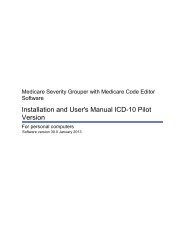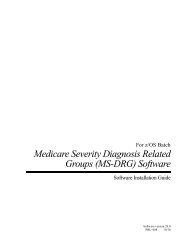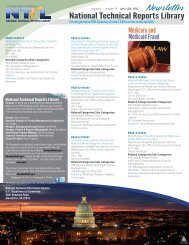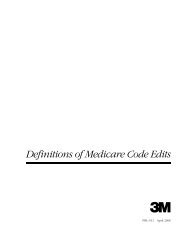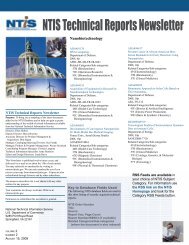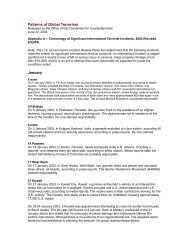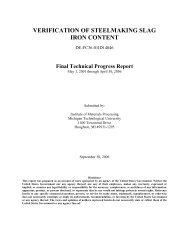DATABASE GUIDE - National Technical Information Service
DATABASE GUIDE - National Technical Information Service
DATABASE GUIDE - National Technical Information Service
You also want an ePaper? Increase the reach of your titles
YUMPU automatically turns print PDFs into web optimized ePapers that Google loves.
NTIS Subject Categories - Alphabetical Listing with Scope Descriptions61See also 77C.For critical assemblies and reactor simulation, use 77K.77I‐Reactor Fuels & Fuel ProcessingProduction, testing, design, or reclamation of nuclear fuel materials,reactor fuel elements (includes cladding) and fuel assemblies.Includes nuclear fuelcycle studies for nuclear materials management;Nuclear fuel reprocessing.For processing of nonrecoverable fuel materials and fuel contaminants,use 77G.77J‐Reactor MaterialsProduction, testing, design, or reclamation of coolants, control materials,moderators, structural materials such as pipe materials;Shielding materials, and steels. Includes fabricated elements orassemblies and specific configurations.For the effects of radiation on materials, see also 71L or 71J.For fuel materials, cladding, or fuel assemblies, use 77I. Excludespower generating equipment and nuclear fusion reactor materials.77K‐Reactor PhysicsReactor kinetics, reactor theory, neutron transport theory, and criticality.Includes critical assemblies and reactor simulators.47‐Ocean Sciences & Technology470‐GeneralIncludes breakwaters; Onshore and offshore facilities; Ocean dredgingoperations; Beach erosion; Harbor engineering; Oceanmining; Anchors; Buoys; Seakeeping; Diving operations andequipment; Decompression equipment.See also 50B, 47H, and 95E.47A‐Marine EngineeringDesign, construction, and maintenance of ships, boats, and relatedequipment; Salvage operations; Naval architecture; Shipyardsand shipbuilding; Submarines; Shipborne containerization.See also 85G.47B‐Dynamic OceanographyOcean waves; Sea level changes; Ocean currents; Ocean tides; Littoraltransport; Sea ice movement.47C‐Physical & Chemical OceanographyPhysical and chemical properties of sea water, the ocean bottom,and estuaries; Sea ice.For glaciers and fresh water ice, use 48H.47D‐Biological OceanographyPlant and animal life in the marine environment; Biological fouling;Marine ecology; Biological aspects of mariculture; Useof marine organisms as bioassay systems; Marine aspects ofestuaries; Marine biology of anadromous fishes.See also 57C, 57H, 57K, 57F, 57Z, and 98F.47E‐Marine Geophysics & GeologyGeophysical and geological studies and surveys as applied to amarine environment; Plate tectonics; Sea floor spreading;Continental drift.See also 48F.47F‐Oceanographic Vessels, Instruments, &PlatformsInstrumentation and equipment to collect and process oceanographicdata; Remote sensors.47G‐HydrographyHydrographic surveying; Ocean bottom topography; Bathymetry.47H‐Underwater Construction & HabitatsClosed environments; Underwater work and construction; Underwaterconstruction equipment.See also 470 General or 95E.79‐Ordnance790‐General79A‐Ammunition, Explosives, & PyrotechnicsProjectiles, fuzes, demolition explosives, detonators, grenades, landmines, high explosives, primers, powder and liquid propellants,flame throwers, and equipment for handling these items;Production, performance, storage stability of incendiaries,pyrotechnics, screening agents (smokes), etc.For nuclear weapons, use 74H.For rocket propellants, use 81.79B‐ArmorDesign, testing, and performance of armor and armor plate includingbullet proof, flak proof, explosion proof, and fragmentproof devices and related equipment.For other types of protective devices, see the application.79C‐BombsHigh‐explosive, fragmentation, antipersonnel, armor piercing, incendiary,napalm, general purpose, and similar types of bombs;Bomb handling equipment; Storage.For bomb directors and bomb release mechanisms, use 79F.For nuclear bombs, use 74H.79D‐Combat VehiclesMilitary vehicles including armored wheeled and track‐laying vehicles,tanks and reconnaissance vehicles, trucks, gun carriers;Components and accessories.79E‐Detonations, Explosion Effects, & BallisticsExplosion effects (except nuclear) such as blast, shock waves, detonationwaves, cratering, earth motion or movement, heat, etc.;Interior, exterior, and terminal ballistics; The study of motion,behavior, and aerodynamics of projectiles thrown or launchedby ordnance projectors; Includes target vulnerability and damageassessment studies, weapons effects.For nuclear explosion effects, use 77D.79F‐Fire Control & Bombing SystemsFire control computers, sights, directors, range finders, gunlaying,bombing radar systems, boresighting, bomb releases, and otherdevices used specifically for directing the firing of weapons orthe dropping of bombs.79G‐GunsSmall arms, automatic weapons, antipersonnel weapons, recoilessweapons, mortars, artillery and naval guns, their accessoriesand components; Gun carriages, gun mounts, remote controlequipment, etc.For ballistic studies, use 79E.For gun control, social violence, use 92C or 43.79H‐RocketsUnguided, self‐propelled projectiles whose trajectory or coursecannot be altered after launch; Ground launched, air launched,or ship launched rockets, launchers, and launch supportequipment.For sounding rockets, use 55D.61



